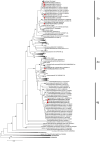Recent Hepatitis E Virus Infection in Wild Boars and Other Ungulates in Japan
- PMID: 40284967
- PMCID: PMC12031028
- DOI: 10.3390/v17040524
Recent Hepatitis E Virus Infection in Wild Boars and Other Ungulates in Japan
Abstract
Hepatitis E virus (HEV) is a zoonotic pathogen with multiple hosts, posing significant public health risks, especially in regions like Japan where game meat consumption is prevalent. This study investigated HEV infection and viral shedding in wild boars, sika deer, and Japanese serows across Japan. A total of 1896 serum samples were tested for anti-HEV antibodies, 1034 for HEV RNA, and 473 fecal samples for viral shedding. Anti-HEV antibodies were detected in wild boars from all seven prefectures studied, while HEV RNA was detected in wild boars from Fukuoka, Oita, and Miyazaki in southern Japan, as well as Yamaguchi prefecture. Genetic analysis revealed subtypes 3b, 4a, and 4g, with 3b being the most prevalent. Subtype 3b exhibited distinct geographical clustering, whereas 4g persisted exclusively in Yamaguchi for over 12 years. Infectious HEV particles were confirmed in wild boar feces, highlighting the risk of environmental contamination and zoonotic transmission. Sika deer showed no evidence of HEV infection, and only one Japanese serow tested positive for antibodies without detectable RNA. These findings underscore the importance of ongoing surveillance to assess the zoonotic risks from game meat consumption and prevention of HEV transmission to humans.
Keywords: Japanese serow; game meat; hepatitis E virus; sika deer; wild boar.
Conflict of interest statement
The authors declare no conflicts of interest.
Figures

Similar articles
-
Molecular Detection and Genetic Typing of Hepatitis E Virus in Wild Animals from Slovakia.Food Environ Virol. 2025 Aug 11;17(3):42. doi: 10.1007/s12560-025-09657-z. Food Environ Virol. 2025. PMID: 40789990 Free PMC article.
-
Prevalence of hepatitis E virus (HEV) Infection in wild boars and deer and genetic identification of a genotype 3 HEV from a boar in Japan.J Clin Microbiol. 2004 Nov;42(11):5371-4. doi: 10.1128/JCM.42.11.5371-5374.2004. J Clin Microbiol. 2004. PMID: 15528746 Free PMC article.
-
Detection and isolation of genotype 3 subtype b hepatitis E viruses from wild boars in Japan.J Vet Med Sci. 2024 May 6;86(5):524-528. doi: 10.1292/jvms.23-0478. Epub 2024 Mar 29. J Vet Med Sci. 2024. PMID: 38556348 Free PMC article.
-
Hepatitis E Virus in the Iberian Peninsula: A Systematic Review.Food Environ Virol. 2023 Sep;15(3):193-211. doi: 10.1007/s12560-023-09560-5. Epub 2023 Jul 11. Food Environ Virol. 2023. PMID: 37434079 Free PMC article.
-
Hepatitis E Virus (HEV) Infection in the Context of the One Health Approach: A Systematic Review.Pathogens. 2025 Jul 16;14(7):704. doi: 10.3390/pathogens14070704. Pathogens. 2025. PMID: 40732750 Free PMC article. Review.
References
-
- World Health Organization Hepatitis E. [(accessed on 27 February 2025)]. Available online: https://www.who.int/news-room/fact-sheets/detail/hepatitis-e.
-
- Patra S., Kumar A., Trivedi S.S., Puri M., Sarin S.K. Maternal and fetal outcomes in pregnant women with acute hepatitis E virus infection. Ann. Intern. Med. 2007;147:28–33. - PubMed
-
- Dalton H.R., Kamar N., Baylis S.A., Moradpour D., Wedemeyer H., Negro F. EASL Clinical Practice Guidelines on hepatitis E virus infection. J. Hepatol. 2018;68:1256–1271. - PubMed
Publication types
MeSH terms
Substances
Associated data
- Actions
Grants and funding
LinkOut - more resources
Full Text Sources

